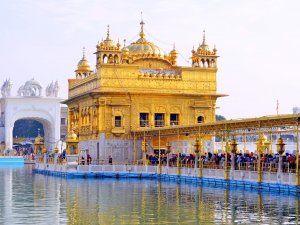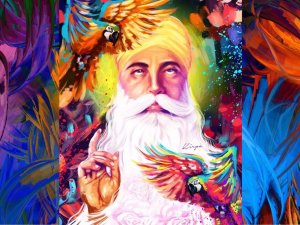Guru Nanak (1469-1539 CE) travelled nearly 38,000 Km in pursuit of dialogue with people of many shades, belief systems, and geographical orientations. Mind you that in the Nanak’s time all of the world’s religions that we know today were in existence.
Among Hinduism, the Siddha denomination was the most prevalent and flourishing. Thus, Guru Nanak began his world travels by visiting with Siddha leadership, particularly the one lead by a famous Siddha Gorakh Nath.
Guru first visited the Siddhas in Nanak Matta at the foothills of the Himalayas mountains. After that, many meetings between Guru Nanak and the Yogis of the Nath sect took place in various parts of India. Gorakh Nath and Macchendra Nath and their teams also met Guru Nanak two or three times. Nearly two centuries later, the Nath sect leaders came again to see Guru Gobind Singh.
The question and answer sessions between Guru Nanak and the Hindu Siddhas are known as Siddh Goshti (Gurmukhi: ਸਿਧ ਗੋਸਟਿ) and nearly 150 selected questions to Guru Nanak were recorded in the Guru Granth and in various Sikh history books.
Among the questions the yogis asked, one was about Guru Nanak’s competence in showing a miracle. As had been recorded in the stories about the prophets and the saints, miracles were often displayed as validity of claims of being Divine or the Divine’s agents. Following the same tradition, the Siddhas asked Guru Nanak for a miracle. They wanted to make sure that Guru Nanak was worthy of prophetic authority.
In response thus spoke Guru Nanak according to Sikh theologian Bhai Gurdas;
ਸਿਧ ਬੋਲੇ ਸੁਨ ਨਾਨਕਾ ਤੁਹਿ ਜਗ ਨੂੰ ਕਰਾਮਾਤ ਦਿਖਲਾਈ॥
ਕੁਝ ਦਿਖਾਈਂ ਅਸਾਨੂੰ ਭੀ ਤੂੰ ਕਿਉਂ ਢਿਲ ਅਜੇਹੀ ਲਾਈ॥
Siddhas spoke to Nanak, Listen, O Nanak! You seemed to have convinced the world of your prophetic authority by showing your miracles (Siddhas apparently thought that Guru Nanak had shown miracles to people to recruit such an impressive number of followers), you must show us some miracle too. Why are you delaying in this?
ਬਾਬਾ ਬੋਲੇ ਨਾਥ ਜੀ ਸ਼ਬਦ ਸੁਨਹੁ ਸਚ ਮੁਖਹੁ ਅਲਾਈ॥
ਬਾਜਹੁ ਸਚੇ ਨਾਮ ਦੇ ਹੋਰ ਕਰਾਮਾਤ ਅਸਾਥੇ ਨਾਹੀ॥
Baba spoke in response, Oh Nath ji! Listen to me as I am telling you in the truthful words. Other than to make people realize that the eternal truth of Divine presence is to be realized in all creations, I have no other miracle to show.. Bhai Gurdas, Vaar 1. Pauri 43.
It is similar to what Guru Nanak said in his composition of the Asa Di Var,
ਬਲਿਹਾਰੀ ਗੁਰ ਆਪਣੇ ਦਿਉਹਾੜੀ ਸਦ ਵਾਰ ॥
ਜਿਨਿ ਮਾਣਸ ਤੇ ਦੇਵਤੇ ਕੀਏ ਕਰਤ ਨ ਲਾਗੀ ਵਾਰ ॥੧॥ SGGS p. 462
A hundred times a day, I am a sacrifice to my Guru; He made angels out of humans, without taking much time.
This very dialogue convinced Siddhas of Guru Nanak’s greatness as witnessed by Bhai Gurdas.
ਸਿਧ ਬੋਲਨ ਸ਼ੁਭ ਬਚਨ ਧੰਨ ਨਾਨਕ ਤੇਰੀ ਵਡੀ ਕਮਾਈ॥
ਵਡਾ ਪੁਰਖ ਪ੍ਰਗਟਿਆ ਕਲਿਜੁਗ ਅੰਦਰ ਜੋਤ ਜਗਾਈ॥
Siddhas spoke their sacred words in praising the Guru saying that, Oh Nanak, you had achieved great accomplishments. You are a great illuminating personality that enlightened the difficult times of kalyug, the “Age of Downfall”. Bhai Gurdas, Vaar 1. Pauri 44.
Similar sentiments about Guru’s miraculous powers were expressed by Guru Arjan later in the Guru Granth.
ਕਹੁ ਨਾਨਕ ਗੁਰਿ ਚਲਤੁ ਦਿਖਾਇਆ ਮਨ ਮਧੇ ਹਰਿ ਹਰਿ ਰਾਵਨਾ ॥ SGGS, p.1018
Says Nanak, the Guru has revealed this miracle; within my mind, I enjoy the Creator and Sustainer, Har, Har.
This article is meant to illustrate how the Founders of Sikhi thought about miracles.
They did use the ancient terminology of miracles. But to them the greatest miracle was the metamorphosis of the human mind, and not a magicians’ tricks to convince people of their divinity.







